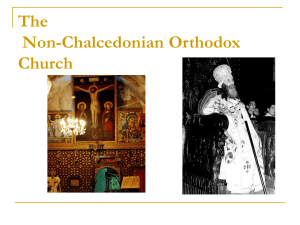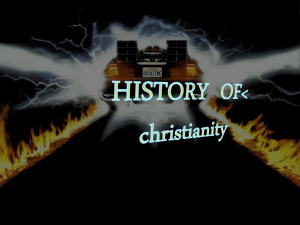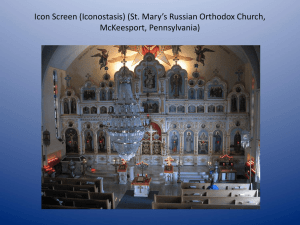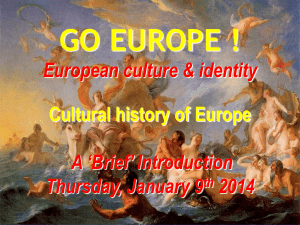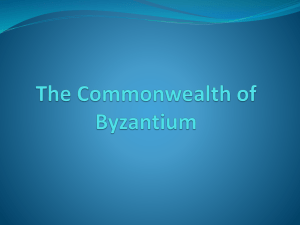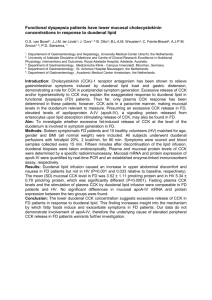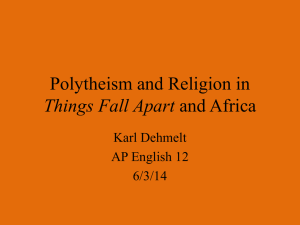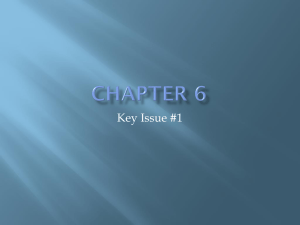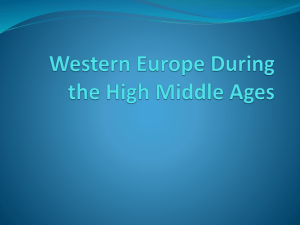Orthodox Christianity
advertisement
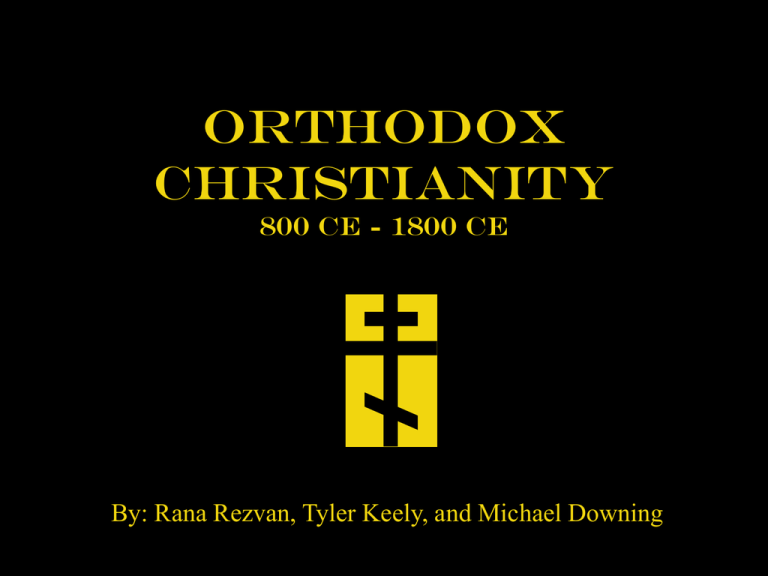
Orthodox Christianity 800 CE - 1800 CE By: Rana Rezvan, Tyler Keely, and Michael Downing The Orthodox Church Exteriors of some Orthodox Churches Exterior of an Orthodox Church in Russia The Orthodox Church Cont. The Eastern Orthodox Church is celebrating Easter. At Jerusalem's Holy Sepulcher Church, believed to be the site of the burial of Jesus Christ, an Easter Saturday's Holy Fire service was held. The Transfiguration of the Orthodox Church in Lviv, Ukraine Interior of an Orthodox Church in Lviv, Ukraine Interior of an Orthodox Church in Aswan, Egypt Interior of an Orthodox Church in Helsinki, Finland Spread of Orthodox Christianity Areas occupied by Orthodox Christians Map of early spread of Christianity Spread of Orthodox Christianity This picture shows the different types of Christianity and when they broke off of the undivided church. This map shows the spread of Christianity over a certain time period, and it also shows where it went from one place to the next. The Orthodox Christian Cross The Sign of the Cross Orthodox Christians make the sign of the Cross in their liturgical worship, their prayers, and their everyday lives. The right hand is held with the thumb meeting the first two fingers, to signify the Trinity - Father, Son, and Holy Spirit. The last two fingers are curled into the palm to represent the two natures of Our Lord Jesus Christ who is God and Man. The right hand is thus taken to the forehead, to the stomach, to the right shoulder, and to the left shoulder as a prayer that the mind, the heart, and the strength of our bodies may be used to the glory of God. Chronology • • • • • • • • • • • • • 301 CE- The Kingdom of Armenia becomes the first state to adopt Christianity as its official religion. 313 CE- The Edict of Milan is issued by Emperor Constantine, which legalized Christianity in the Roman Empire. 325 CE- Constantine calls the First Ecumenical Council at Nicaea to condemn the Arian heresy, which had taught that the Son was inferior to the Father. The First Council of Nicaea resulted in the first Christian doctrine, called the Creed of Nicaea. 381 CE- The Second Ecumenical Council is held at Constantinople where the text of the Nicene Creed is published. 431 CE- The Third Ecumenical Council at Ephesus condemns the Nestorian heresy and approves the honor of the Virgin Mary as Theotokos (God-Bearer or Mother of God). The Nestorians go into exile in the Persian Empire and become the Assyrian Orthodox Church of the East. 451 CE- The Fourth Ecumenical Council at Chalcedon condemns the Monophysite heresy and confirms that Christ had both a divine and a human nature. The Armenian, Coptic, Ethiopian, and Syrian Orthodox Churches would remain Monophysite; the Greek Orthodox Church and the Western Church adopted the Chalcedonian or Dyophysite position. This Council also gives Constantinople equal standing with "Old" Rome. 730 CE- Byzantine Emperor Leo III bans the idolization of images and relics (objects of religious significance), which begins the first period of Iconoclasm. 787 CE- The Seventh Ecumenical Council, the Second Council of Nicaea, reestablishes the idolization of images. 800 CE- The first emperor since Constantine, Charlemagne Emperor of the West is crowned by Pope Leo III. 815 CE- Emperor Leo V calls a council again banning images; this begins the second period of Iconoclasm. 843 CE- Byzantine Empress Theodora reestablishes the idolization of images on the First Sunday of Lent, which became known as the Sunday of Orthodoxy. 862 CE- Byzantine Emperor Michael III sends Constantine and his brother Methodius to Moravia to teach Christianity to the Slavs. They translated the Bible and other religious writings into Old Church Slavonic. These "Apostles to the Slavs" also had the support of the Popes of Rome, Hadrian II and John VIII. 867 CE- Rivalry between Greek and Latin missionaries to Bulgaria causes Photius to hold a council that dethrones Pope Nicholas III and attacks Western notions of papal primacy and many Western practices. The Eastern church now dates the East-West split from this event (the Photian Schism). Chronology Cont. • • • • • • • • • • 869 CE- Emperor Basil I, who had murdered Michael III, seeks papal support by dethroning Photius and bringing back Ignatius. A council held in support of Ignatius is considered by the West to be the Eighth Ecumenical Council (Constantinople IV). 877-880 CE- Ignatius dies, and Photius is restored as Patriarch. 988 CE- Russia becomes a Christian nation. 1054 CE- Western Cluniac monks take over Greek monasteries in southern Italy, Byzantine Patriarch Michael Caerularius reacts by closing Latin churches in Constantinople. Pope Leo IX sends Cardinal Humbert (considered an expert on Eastern Christianity) to Constantinople to work things out. Not knowing Leo IX had died, Humbert cuts off Patriarch Michael in Leo's name. The Western church dates the East-West split from this event (the Great Schism). 1261 CE- Emperor Michael Palaeologus conquers Constantinople for the Byzantines. 1439 CE- Byzantine Emperor John VIII, who was hoping for Western military aid against the Turks, travels to Italy and negotiates a reunion of the Eastern and Western Churches at the Council of Florence. When he returns East, leaders of the Greek Orthodox Church refuse to accept the reunion. 1448 CE- The Russian Orthodox Church declares its independence from Constantinople and elects its first native-born Russian bishop, Jonas I. 1589 CE- Patriarch Jeremias II of Constantinople raises Metropolitan Job of Moscow to the rank of Patriarch of Moscow and of all Russia, making him the head of the largest Orthodox church. Moscow comes to be called "the Third Rome.“ 1596 CE- At the Union of Brest-Litovsk, a few million Ukrainian and Byelorussian Orthodox Christians, who were living under Polish rule, leave the Russian Orthodox Church and recognize the Pope of Rome without giving up their Byzantine liturgy and customs. This was the beginning of what is known as the Uniate, Eastern Rite Catholic, or Greek Catholic Church. 1652-1680: Patriarch Nikon of Moscow revises liturgical books to bring them into allegiance with the Greek Orthodox liturgy. Those against this reform were excluded from the Russian Orthodox Church and become known as Old Believers, which are now divided into several sects. Spread/Impact of Orthodox Christianity Eastern Europe/Middle East Political Intellectual Emperors made the transition into the role of allpowerful Christian monarchs. Single ruler with supreme legal and religious authority prevented the breakup of the Eastern Empire. Writing system called Cyrillic came to be used by Slavic Christians adhering to the Orthodox-that is Byzantine. Christian emperors followed and represented the ideas of Roman imperial rule. Religion Art/Architecture Byzantine emperors established Christianity as their official religion. Christianity led to the advancements in arts which spread west. United Byzantine people through Christianity. Byzantine religious art featured stiff but arresting images of holy figures against gold background. Constantinople Hagia Sophia Cathedral. Design and ornamentation of churches and monasteries Technology Economy Design and ornamentation of churches made for beautiful centers of worship. Society Byzantine represented the continuation of Roman imperial rule and inherited provincial forms of Roman Law enforced by Christian Emperors. Society based upon trade and production. Christian emperors continued the Late Roman inclination to set prices, organize grain shipments to the capital, and monopolized trade in luxury goods. Archaeology and records kept by Christian monasteries. Spread/Impact of Orthodox Christianity Cont. Eurasia Political Intellectual Kievan Russia had a chief bishop to govern church affairs. In the 12th century, Orthodox became involved in government administration. 17th century- Tsar Peter the Great brought the Russian Orthodox Church under state control. Orthodox Christianity was chosen by Vladimir I instead of Islam due to ban on alcohol. The East-West schism led to Russian adoption of Orthodox over the Roman Catholic Church due to difference in Communion. Religion Art/Architecture The expansion of Orthodox in Kievan Russia acted as a barrier against the expansion of Latin Christianity. Russia’s principle religion has been Orthodox for many centuries. Russian Orthodox cathedrals had Byzantine influence: small dome and symmetrical Greek-cross floor plan. Cathedrals and churches built with stone. Glassmaking used in church. Technology Economy Multi-domed churches differed from ideas of Christian design. Society Higher class = higher duties in church. Times of famine caused polytheistic uprisings. Orthodox clergymen in government collected taxes and other fees to do with trade. Ancient Russia traded greatly with Byzantium and other Orthodox groups Orthodox Christianity’s Change Over Time • • • • • Christianity started with all but one church. Now, it has many different denominations and ways to worship. The Great Schism changed Orthodox Christianity forever. – It divided the eastern orthodox and Roman Catholic churches (1054 C.E.). – It also created opportunity of the formations of new denominations of Christianity. Christianity in its early stages had 7 heavens with the supreme god at the top. Now, there is one heaven. The Great Schism- Greek/Eastern Orthodoxy has remained similar in many ways. Reasons of the separation of the churches were: – Differences in the nature of the holy spirit. – Date of the Easter celebration. – Eastern Orthodox was more philosophical but Roman Catholic was more legalminded. Comparisons: Orthodox/ Protestant/ Roman Catholic Orthodox Protestant Roman Catholic Apostolic Succession: Important part of Orthodox belief; ensures continuity with the church that Christ founded. Apostolic Succession: With the exception of the Anglicans and some Lutherans, this idea is rejected. For them it is important to emphasize the continuity of teaching with that of the apostles rather than a direct line of succession. Apostolic Succession: Like Orthodoxy, this is important to the church. Composition of the Bible: They accept the 39 Old Testament and 27 New Testament books, but also a collection of books not found in the original Hebrew Bible. These are known as Deuterocanonicals- a second canon of scripture. Composition of the Bible: Protestants reject the Deuterocanonicals as not being inspired scripture. They call them Apocrypha (Greek: 'Hidden Things'). Composition of the Bible: Agrees with Orthodoxy as to the validity of these books. Qualification for Clergy: Priests and Bishops must be male, but deaconesses are permitted, though the order is dormant. Priests and deacons may marry before ordination but not after. Bishops, on the other hand, must be celibate (unmarried). Qualification for Clergy: The majority of Protestants do not require celibacy as a condition of election to the clergy. Many churches practice female ordination. The issue of female Bishops is currently being debated in the Anglican church. Qualification for Clergy: All clergy are required to be male. Priests and Bishops must also be celibate, with the exception of 'Eastern Rite' Catholics, who are allowed to have married priests. Marriage and Divorce: Marriage is a mystical union between a man and a woman. Divorce is generally only allowed in cases of adultery, though there are exceptions. Marriage and Divorce: Marriage is a contract, but is not unbreakable. Divorce is discouraged, but permitted as evidence of human weakness. Some denominations permit remarriage in church. Marriage and Divorce: Marriage is an unbreakable contract. Divorce is not permitted unless there is some accepted obstruction to the marriage. In this situation, an annulment (invalidation of a marriage) may be granted. Christianity in Today’s World • • • • • • • Today in the world, there are an estimated 2.1 billion Christians. 33% of religious people in the world today practice Christianity or a type of Christianity. Christianity is the largest world religion. There are 38 counted Christian groups practiced in the world today. These include (Catholic, Protestant, Baptists, etc.). Today Jesus is celebrated as the son of God and the Lord and Savior on holidays such as Christmas and Easter. Architecture from Byzantine times is used to design elegant churches and cathedrals. Religious artwork like that in Eastern Europe can still be seen at Christian worship centers around the world. Division of Assignments: • • • • • Spread and Impact of element on regions (P.I.R.A.T.E.S.) – Tyler Keely Chronology for given timeframes for element. – Rana Rezvan Maps, charts, and images that visually help presentation of element and help explain it. - Michael Downing, Rana Rezvan helped Analyses that explain the change and comparative nature of the element to other like elements. – Analyses: Michael Downing Comparison: Rana Rezvan Role that the element plays in today’s world. – Tyler Keely
